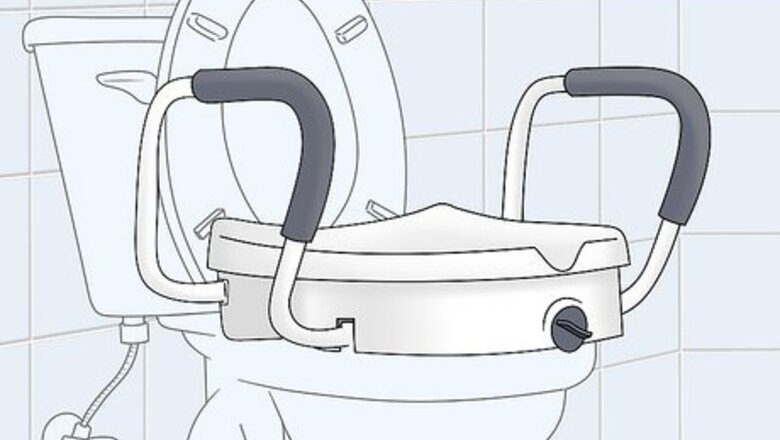
views
Replacing Your Existing Toilet Seat
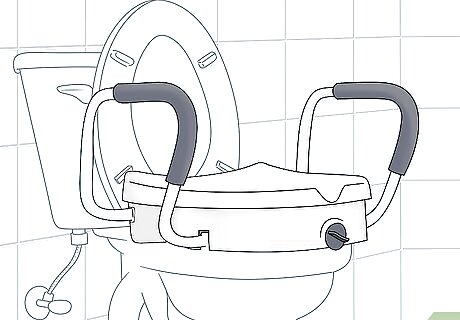
Purchase a raised toilet seat that fits your existing toilet. There are 2 types of toilets and therefore, 2 types of toilet seats: regular and elongated. Regular toilets are usually 16.5 inches (42 cm) long, whereas elongated toilets are usually 18.5 inches (47 cm) long. Regular toilets are 14.25 inches (36.2 cm) wide (from the outside edges), whereas elongated toilets are 15 inches (38 cm) wide. When purchasing a raised toilet seat, make sure you purchase one that will fit the type of toilet you have. It’s usually fairly obvious which type of toilet you have, but if you aren’t sure, use a tape measure to confirm. Keep in mind that not all raised toilet seats come with their own lids. If you want to continue to have a lid on your toilet, make sure to purchase a raised seat that has one.
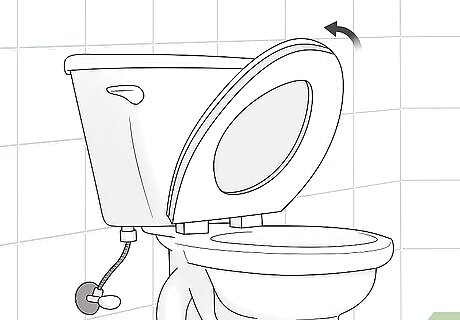
Lift your existing seat and lid to make room for the raised seat. Raised toilet seats that replace your existing seat simply sit on top of the ceramic of your toilet bowl. Most can be placed on your toilet without you needing to remove your existing seat as there’s enough room between the back of the raised seat and your tank. Instead, you can simply lift the existing seat and lid up and lean it against the tank. When the raised seat is on the toilet, you won’t be able to use the original seat and lid. If you need to use the original seat and lid, you’ll need to remove the raised seat first.
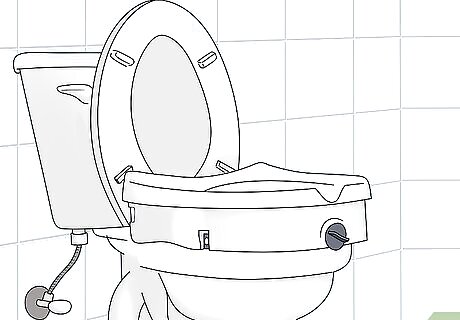
Test if the existing seat and lid can stay or needs to be removed. Place the raised toilet seat on the toilet bowl with the existing seat and lid flipped up. If there is not enough room for the existing seat and lid to sit against the tank, you’ll need to remove it before you install the raised seat.. Raised toilet seats that sit on the bowl are designed to be temporary. They can be removed for cleaning and moved to other locations when needed.

Remove your existing toilet seat if required. Kneel down in front of your toilet and reach one hand under the toilet to hold one of the nuts securing the toilet seat screw in place. Hold the nut still while using a screwdriver to loosen the screw from above. Once loose enough, remove the nut with your hand and pull out the screw. Repeat the process for the second screw and nut. Lift off the existing seat and lid and set it aside. Do not throw out the existing seat. Give it a good cleaning and store it somewhere so it can be reinstalled later if needed.
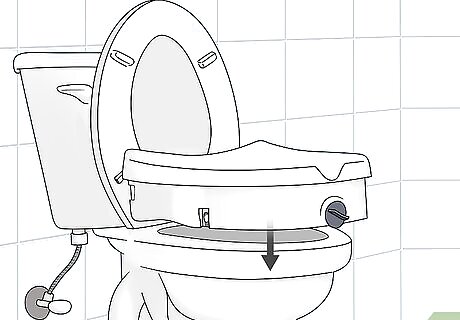
Insert the raised seat into the toilet bowl and secure the flanges. Most raised toilet seats have 1 or more flanges which hold the seat inside the toilet bowl. You may need to tilt the seat slightly forward or backwards in order to slip the flanges into the bowl. Once inserted, push the raised seat down onto the bowl until it’s secured. Shake the seat gently to make sure it’s been properly installed and balanced. Once installed, the raised toilet seat insert may wiggle slightly, but it shouldn’t be able to wobble significantly.
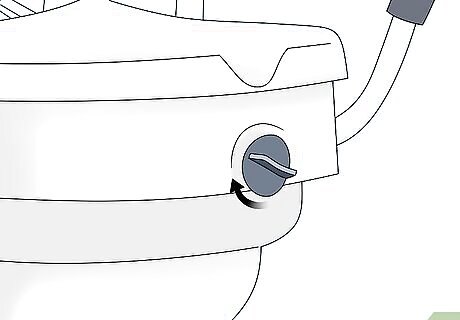
Use the adjustment knob, if required, to secure the raised seat. Some raised toilet seats have an adjustment knob at the front that’s attached to an adjustment bracket inside the toilet bowl. Turn the knob counterclockwise to loosen the adjustment bracket. Turn the knob clockwise to tighten the adjustment bracket. Turn the knob to tighten the adjustment bracket against the toilet bowl and secure it in place. Check the adjustment knob once a week to make sure it remains tight and secure. The adjustment bracket on the inside of the bowl may loosen over time as the seat is used.

Secure clips or clamps on the outside of the toilet bowl, if needed. Some raised toilet seats also have clips or clamps that secure the seat to the outside of the toilet bowl. If the raised seat has such clips or clamps, make sure they’re properly secured to the outside of the toilet based on the manufacturer’s instructions. In most cases, seats with clips or clamps will have 4 of them, 2 on each side of the toilet bowl. Check these clips or clamps on a weekly basis to ensure they remain in place and secure.
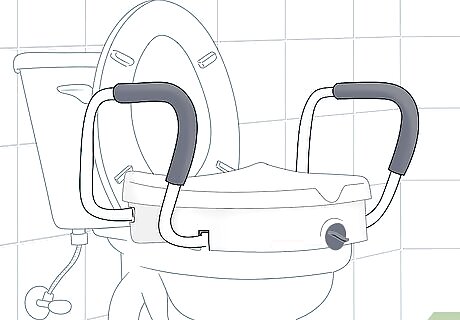
Attach the toilet seat support arms if required. Some raised toilet seats include support arms on either side of the seat that assists you with sitting down and getting up. In some cases, those support arms come pre-installed and no additional steps are required. In other cases, those arms need to be attached once the raised seat is installed. Attach the arms based on the manufacturer’s instructions. Folding arms are typically attached to the raised seat at the back, with each arm having 1 attachment location. Stationary arms are typically attached to the raised seat at the sides, which each arm having 2 attachment locations.
Installing a Toilet Seat Riser
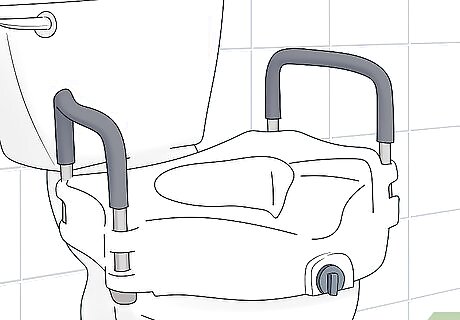
Buy a toilet seat riser that fits your existing toilet. Toilet seat risers are designed to fit the kind of toilet you have, either regular or elongated. Before purchasing a riser, make sure you know what type of toilet you have, either regular or elongated. Regular toilets are typically 16.5 inches (42 cm) long and 14.25 inches (36.2 cm) wide, whereas elongated toilets are typically 18.5 inches (47 cm) long and 15 inches (38 cm) wide. Toilet seat risers are designed to sit on the toilet bowl with the existing seat and lid secured on top. Some toilet seats (such as those made of wood) may not have large enough screw holes to allow for a riser to be installed. In these cases, you’ll need to purchase a new toilet seat to install on top of the riser.
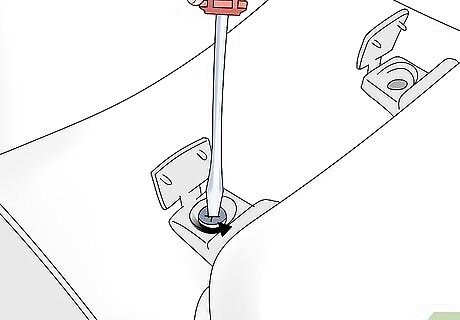
Take off your existing toilet seat and lid assembly. Open the 2 flaps that protect the toilet seat screws at the back of the toilet seat. Use one hand to hold the nut still on the underside of the toilet while using your other hand to loosen the screw with a screwdriver. Keep loosening the screw until you’re able to take the nut off. Do the same thing to the second screw, then remove the seat and set it aside. This is a great opportunity to completely clean your toilet bowl and seat. Once the riser is attached, you will not be able to move it to clean the top of the toilet bowl.
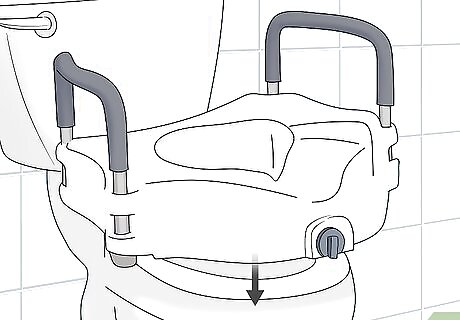
Put the toilet seat riser on the bowl and align the screw holes. To secure the riser and toilet seat, you’ll be using the screws that came with the riser. They’re much longer than the ones that secure your toilet seat, as they need to fit through both the seat and the riser. Once the toilet seat riser is set on the toilet bowl, check that the 2 holes line up properly. Some toilet seat risers come with foam pieces that sit between the riser and the toilet to protect the ceramic. Make sure the foam pieces are properly attached to the riser (if they did not come preinstalled) before you put the riser on the toilet.
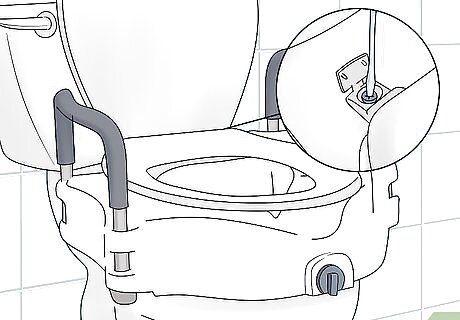
Place your toilet seat on top of the riser and align the holes. As with the riser, make sure the 2 screw holes on the toilet seat line up properly with the holes in the riser and the bowl. Slide the screws into the holes to make sure they’re properly aligned. If they aren’t aligned, shift the seat and/or riser until they’re able to slide all the way through. This is the step where you may find that the holes in the toilet seat are too small for the new screws. If this happens, you will need to purchase a new seat before proceeding.
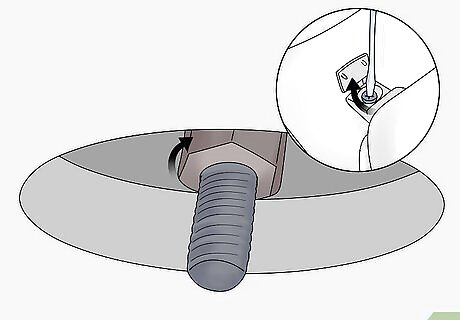
Secure the 2 screws through the seat, riser, and toilet. Use 1 hand to reach under the toilet on either side and attach the nut to the new screw. Use your hand to tighten the nut as much as you can, then use the same hand to hold it still. Use your opposite hand to secure the screw with a screwdriver until it’s tight. Repeat the process with the second screw and nut. The type of screwdriver required depends upon the screws that came with the riser. Don’t forget to close the screw flaps on the toilet seat once both screws are secured.

















Comments
0 comment